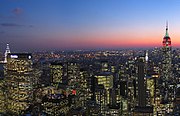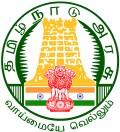Portal:Tamils
|
The Tamils (/ˈtæmɪlz, ˈtɑː-/ TAM-ilz, TAHM-), also known as the Tamilar, are a Dravidian ethnolinguistic group who natively speak the Tamil language and trace their ancestry mainly to the southern part of the Indian subcontinent. The Tamil language is one of the longest-surviving classical languages, with over two thousand years of written history, dating back to the Sangam period (between 300 BCE and 300 CE). Tamils constitute about 5.7% of the Indian population and form the majority in the South Indian state of Tamil Nadu and the union territory of Puducherry. They also form significant proportion of the population in Sri Lanka (15.3%), Malaysia (7%) and Singapore (5%). Tamils have migrated world-wide since the 19th century CE and a significant population exists in South Africa, Mauritius, Fiji, as well as other regions such as the Southeast Asia, Middle East, Caribbean and parts of the Western World.
Archaeological evidence from Tamil Nadu indicates a continuous history of human occupation for more than 3,800 years. In the Sangam period, Tamilakam was ruled by the Three Crowned Kings of the Cheras, Cholas and Pandyas. Smaller Velir kings and chieftains ruled certain territories and maintained relationship with the larger kingdoms. Urbanisation and mercantile activity developed along the coasts during the later Sangam period with the Tamils influencing the regional trade in the Indian Ocean region. Artifacts obtained from excavations indicate the presence of early trade relations with the Romans. The major kingdoms to rule the region later were the Pallavas (3rd–9th century CE), and the Vijayanagara Empire (14th–17th century CE). The island of Sri Lanka often saw attacks from the Indian mainland with the Cholas establishing their influence across the island and across several areas in Southeast Asia in the 10th century CE. This led to the spread of Tamil influence and contributed to the cultural Indianisation of the region. Scripts brought by Tamil traders like the Grantha and Pallava scripts, induced the development of many Southeast Asian scripts. The Jaffna Kingdom later controlled the Tamil territory in the north of the Sri Lanka from 13th to 17th century CE. European colonization began in the 17th century CE, and continued for two centuries until the middle of the 20th century. (Full article...) Nagore Dargah (also called Nagoor Dargah or Syed Shahul Hameed Dargah or Nagore Andavar dargah) is a dargah built over the tomb of the Sufi saint Nagore Syed Abdul Qadir Shahul Hamid (1490–1579 CE). It is located in Nagore, a coastal town in the South Indian state of Tamil Nadu. The outer doors of the dargah are kept open always, while the internal doors are open from 4:00 am to 07:00 am and from 6:00 pm to 10:00 pm. On Fridays, the doors are additionally kept open between 12:00 pm and 2:30 pm. Shahul Hamid is believed to have performed many miracles in Nagore, and cured the physical affliction of king Achuthappa Nayak, a 16th-century Hindu ruler of Thanjavur. He is locally referred to as Nagore Andavar, meaning the "Ruler of Nagore" and Qadir wali baba. Nagore dargah as it stands now, is believed to have been built by ardent devotees of Shahul Hamid, with major contribution from Hindus. There are five minarets in the dargah, with the Hindu Maratha ruler of Thanjavur Pratap Singh (1739–1763 CE), building the tallest minaret. The dargah is a major pilgrimage centre that attracts pilgrims from both sufi Islam and Hinduism, symbolizing peaceful coexistence between the two religions. The most prominent event celebrated at Nagore Dargah is the Kanduri festival (Urus Mubarak), a fourteen-day commemoration of the death anniversary of Shahul Hamid. Common worship practices at Nagore dargah include the presentation of offerings, accompanied by the playing of musical instruments like nadaswaram, typical of Hindu religious tradition. The Shifa Gunta, a pool within the precincts of the dargah, is considered sacred; pilgrims take a holy dip in it. The hereditary board of trustees performs all the official and duties of the dargah. The governance and upkeep of the dargah are overseen by an 11 Member board of trustees, which operates under a court-decreed scheme established by the Madras High Court. (Full article...)  Velupillai Prabhakaran (listen (US English); Tamil: வேலுப்பிள்ளை பிரபாகரன்; [ˈʋeːlɯpːiɭːaɪ pɾaˈbaːhaɾan]; 26 November 1954 – 18 May 2009) was a Tamil revolutionary. Prabhakaran was a major figure of Tamil nationalism, and the founder and leader of the Liberation Tigers of Tamil Eelam (LTTE). The LTTE was a militant organization that sought to create an independent Tamil state in the north and east of Sri Lanka in reaction to the oppression of the country's Tamil population by the Sri Lankan government. Under his direction, the LTTE undertook a military campaign against the Sri Lankan government for more than 25 years. Prabhakaran was the youngest of four children, born in Valvettithurai, on Sri Lanka's Jaffna peninsula's northern coast. Considered the heart of Tamil culture and literature in Sri Lanka, Jaffna was concentrated with growing Tamil nationalism, which called for autonomy for Tamils to protest the discrimination against them by the Sinhalese-dominated Sri Lanka government and Sinhalese civilians since the country's independence from the United Kingdom in 1948. (Full article...) Tamil People Countrywide: India • Sri Lanka • Canada • Malaysia • Singapore • South Africa • England Related Ethnic Groups: Brahui • Gond • Kannadiga • Khonds • Kodava • Oraon • Malayali • Telugus • Tuluvas Related indigenous Groups: Badagas • Toda • Kuruba
See also: List of Tamil people, Tamil script, Tamil Script Code for Information Interchange
The following Wikimedia Foundation sister projects provide more on this subject:
Discover Wikipedia using portals |
























































